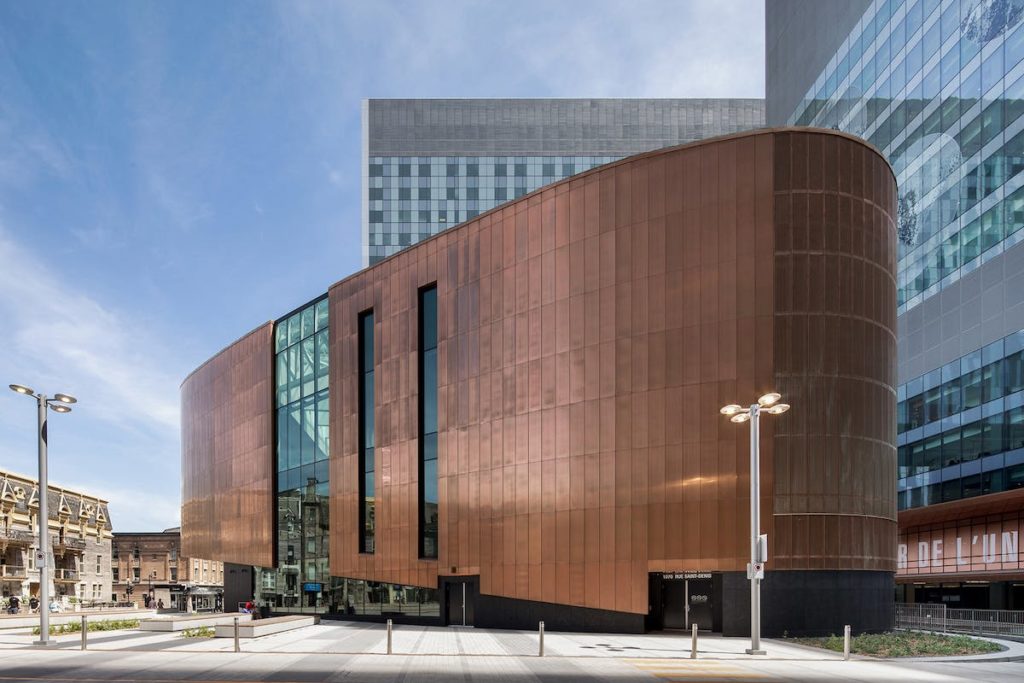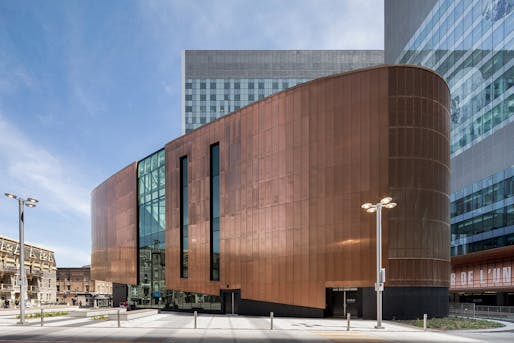[ad_1]
anchor
The Copper Development Association (CDA) in unison with the Copper Alliance has named the eleven 2022 winners of the annual North American Copper in Architecture Awards (NACIA).
Inaugurated in 2008, the award recognizes outstanding applications of the material in restoration projects and new construction on the continent. Copper has typically been used as a preferred formal and decorative element in government architecture, which is reflected in the inclusion of several courthouse and similar projects, and is important to the development of certain cities’ vernacular architecture, as seen by the list’s juxtaposed Montreal project.
Past winners have included myriad renovations of state houses, the Canadian War Museum, many higher-ed projects, and several major historic renovations and religious commissions.
Scroll down to see the full list of this year’s winners with descriptions of each project.
St. Joseph the Worker Catholic Church and Day Chapel by Sparano + Mooney Architecture (West Jordan, UT)
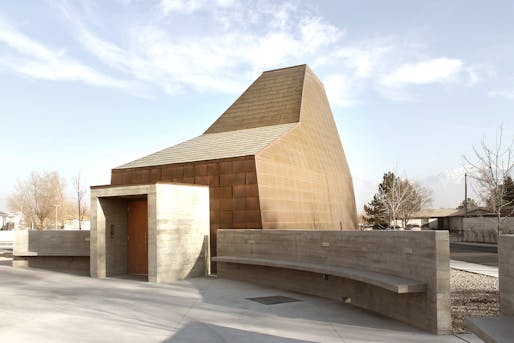
St. Joseph the Worker Catholic Church and Day Chapel by Sparano + Mooney Architecture. Photo: Jeremy Bittermann
Description: Custom bent, flat lock copper panels, for example, were used on the exterior of the Day Chapel, and copper also clads the skylight over the altar, thereby incorporating tangible references to the parish’s mining and construction history.
In keeping with the design goal of sustainability, the Day Chapel, which is more frequently used than the main sanctuary, is thermally isolated thereby reducing the daily heating and cooling loads. The modest, humble nature of the copper configured within new volumes and surfaces seek to both reassure and inspire.
The design incorporates these familiar materials manipulated to become extraordinary. As they are transformed by the “worker,” they are crafted into surfaces expressing the skill of the tradesperson rather than the qualities of the raw material. The modest, humble nature of these ordinary materials configured within new architectural forms and surfaces seek to both reassure and inspire. Copper is reserved for the most sacred aspects of the church and clads the skylight over the altar and the exterior of the day chapel.
3-D Copper Dome by CopperWorks Corps (Athens, AL)
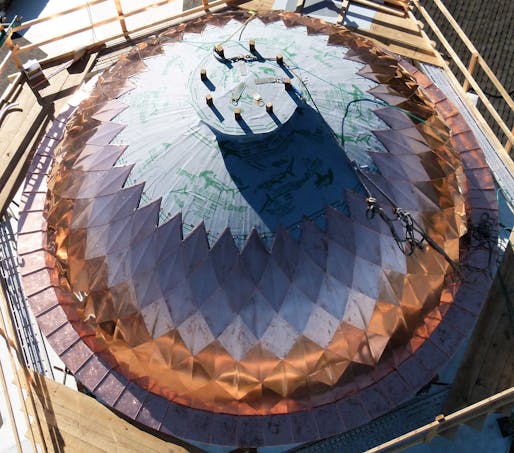
3-D Copper Dome by CopperWorks Corps. Image: Jenn Delle of Ornametals
Description: For the renovation, copper was used as the historically accurate material. A new plan, however was suggested which called for a change in shape and would reveal a new modernized facade, taking shape as three-dimensional panels. Two hundred eighty-eight rauten tiles were fabricated from 0.7mm thick copper to cover the dome. Its dimensions are a 213 square foot area, a 22.9-foot diameter, and a height of 10.49 feet. The tiles’ spatial effect was created by working standing edges into the adjacent sides of the diamonds. These ridges are several millimeters high at the bottom tip of each diamond and reduced to zero on the opposite side. This technique raises the central axis and creates a harmoniously constructed 3-D effect. Different edge lengths and shapes were used when characterizing the copper tiles: wide-produced square profiles, pointed diamonds, and other special formats. Half-squared panels were used for the first row at the sphere’s base. The width and length of the copper panels change with each subsequent row.
Finally, the team completed the printed hemisphere with a broad copper base and eight decorative brackets with floral motifs. The sphere was created as a detailed replica of a dismantled ornament and was fabricated in two halves. Maneuvering both halves was quite challenging because the number of assembled components, sizes, and overall weight of the cupola kept changing. Therefore, the tower’s lower half was manufactured horizontally and erected to meet its other half. Once upright, the decorative and half brackets were assembled onto the tower’s lower portion, and the surrounding cornice was soldered to the connection profile.
Summit on the Park Aquatic Center by CASS Sheet Metal (Canton, MI)

Summit on the Park Aquatic Center by CASS Sheet Metal. Photo: CASS Sheet Metal
Description: The Summit Aquatic Center reroof project was necessary to solve a great number of problems with a previous effort. Correcting these issues required full redesign of perimeter substrate framing and replacement of damaged plywood decking.
Problems included lack of vapor barrier, missing insulation, improper control of negative pressure, overly long panels, and poorly designed and executed panel transverse seams.
The new roof solution includes 25,000 square feet of 16-ounce copper standing seam installed over high-temperature underlayment, plywood, insulation, and air and vapor barrier on top of the existing steel deck. The Aquatic Center now has a beautiful new, long-lasting roof system capable of providing the 100 years possible with copper.
Utah Governor’s Mansion by CMR Construction & Roofing (Salt Lake City, UT)

Utah Governor’s Mansion by CMR Construction & Roofing. Photo: Ary Lezcano for CMR
Description: The Utah Governor’s Mansion was experiencing issues with its roof despite it being well within the usual long lifespan. The project team was directed to provide a beautiful new copper roof that would suit the building and climate and last for decades to come.
The solution showcases 90 squares of custom rectangular and diamond copper tiles. Skilled artisans and sheet metal specialists delivered an exquisite roof, complete with hand-fabricated tapered diamond turrets, that will continue to impress and protect well into the future. The entire project was completed in record time—90 squares in 100 days.
Lupton Hall Roof by Hoffman Architects (Farmingdale, NY)
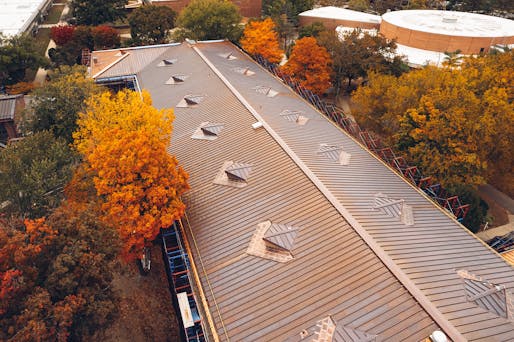
Lupton Hall Roof by Hoffman Architects. Photo: Marko Bistakis
Description: Copper provided a historically accurate solution for the Lupton Hall roof replacement.
This project required over 8,100 square feet of copper roofing, including both batten and flat seam styles and related flashing. Challenging aspects included extensive copper built-in gutters with related downspouts, louver, fascia, soffits, and a brass snow guard system.
The new copper roof is the preferred, long-lasting, durable solution for the building owner.
Lubber Run Community Center by VMDO Architects (Arlington, VA)
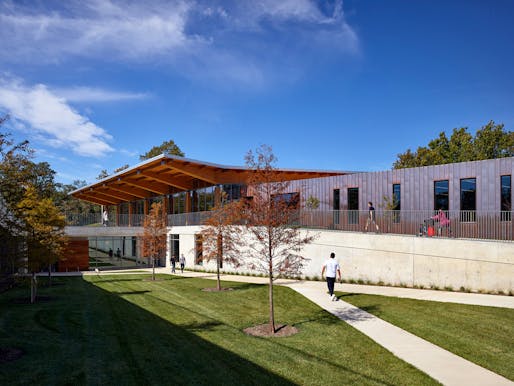
Lubber Run Community Center by VMDO Architects. Photo: Alan Karchmer
Description: Connection to nature and preservation of open space were essential to designing the new building, and as a result, parking and some programs are located underground to allow for increased outdoor amenities at ground level. The building envelope that acts as the threshold between indoors and outdoors is significant in both its high performance and economic efficiency.
The copper system that wraps the north facade was chosen for its ease of maintenance due to its patina over time and its improvement with age. The copper system consists of a vertical standing seam copper (20-ounce panels with 16-ounce flashing) with a rain screen attached to thermal break Z furring with over 4.5-inch of insulation over a fluid applied air barrier. In areas where the copper cladding went over windows, a perforated copper panel (20-ounce, 1/16-inch on 3/32-inch stagger) was provided that completed the copper volume at the exterior but preserved visibility and exterior views from the interior.
Horizontal girts were installed to support the panels, and before insulation or the copper attached, an air infiltration test was performed to confirm the performance of the system and identify any small gaps. The air-tight quality of the copper facade directly contributes to Lubber Run’s performance as a net-zero energy facility and provides a dynamic material display upon its approach.
Havergal College Upper School by Diamond Schmitt (Toronto, ON)
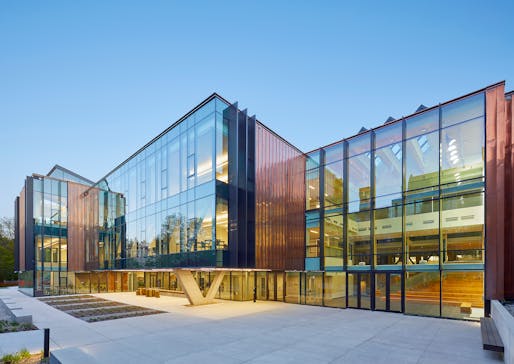
Havergal College Upper School by Diamond Schmitt. Photo: Diamond Schmitt
Description: Copper has a unique ability to be formed into countless shapes and forms. At Havergal, this contemporary expression is both taut and crisp. Large rhythmic copper clad walls are made from 16-ounce copper pans with 2-inch single-lock standing seam, adding depth and scale. A sprung edge was introduced into the pan profiles to mitigate oil-canning and facilitate expansion and contraction of the copper throughout the day. Flashing transitions meet a variety of conditions from sill and soffit datums, curtainwall integration to special building movement joints and parapets. 16-ounce copper-clad parapets feature a strong projecting shadow reveal and thin top edge, brake-formed with s-lock joints along the length. All parapets have a woven mesh underlayment between copper and roofing to promote a drainage layer out to roof below and separate roofing membrane from copper.
One of the innovations developed was how to maintain and return the parapet shadow reveal between different back-sloping parapet widths. A simple approach used a 1-inch standing seam at the different parapets to enable an infill condition that could be hooked and have the reveal appear seamless around the building. Another challenge was how a 150-millimeter structural joint between existing and new building could be incorporated at a back-sloping parapet. The result was a sloped, built-up copper pan curb.
This beautiful building will not remain static as it will continue to transform, evolve, and settle with its surroundings gracefully for many years.
D.C. Court of Appeals by Building Conservation Associates, Inc. (Washington, D.C.)
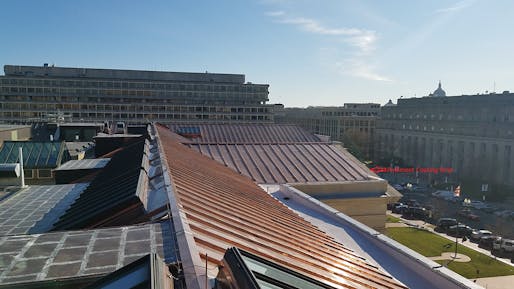
D.C. Court of Appeals by Building Conservation Associates, Inc.. Photo: Joe Schneider
Description: The D.C. Court of Appeals is the fourth oldest building in Washington, D.C. Its new copper roof provides a historically accurate solution to replicate original design intent while correcting problems caused by a poorly executed repair effort.
The 35,000 square foot roof replacement was completed in two phases. This solution includes both flat and batten seam roofing as well as related flashing. Challenging aspects included a new copper enclosure for the rooftop electrical cabinet and incorporation of new access stair ladder. Copper provides a beautiful, long lasting roofing solution to this majestic building.
Adler Planetarium by Hutchinson Design Group and Wight & Company (Chicago, IL)
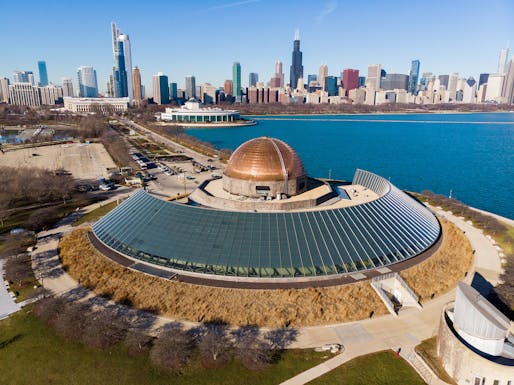
Adler Planetarium by Hutchinson Design Group and Wight & Company. Photo: Troop Contracting
Description: The Adler Planetarium, located on Northerly Island on Lake Michigan in the Chicago Museum District, was the first planetarium in the Western Hemisphere and is a national historical landmark.
After 70 years, the Planetarium’s dome reached the end of its service life. Moisture intrusion was apparent near weak points in the design, such as the base of the dome, internal gutters, and drains. To maintain the historical accuracy of the structure, the design team restored the dome using copper, one of the most durable, long-lasting roofing materials.
The renovated copper-clad dome is composed of an internal gutter and base copper,16 rows of shop-fabricated copper panels, topped by a dome cap. Each of the lower dome panel locks is covered with a decorative horizontal rib giving the dome an aesthetic visual lightness.
CHUM Auditorium by NEUF architect(e)s and CannonDesign (Montreal, QC)
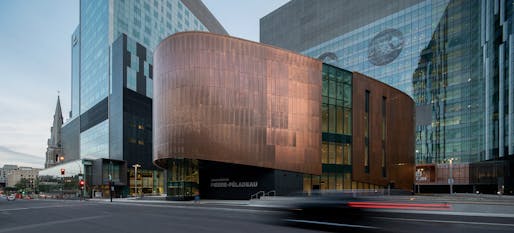
CHUM Auditorium by NEUF architect(e)s and CannonDesign. Photo: Adrien Williams
Description: For the Centre hospitalier de l’Université de Montréal (CHUM), copper, a noble material, was reinterpreted as a contemporary form to signal key elements within the curtain wall. The project’s central architectural element is a 365-seat auditorium named the “amphithéâtre Pierre-Péladeau,” situated at the heart of the urban plaza in copper clad. The building envelope tells a story of layering and un-definition. It articulates itself at night when moments of translucency and perforation light up components of the interior.
This last phase of the CHUM hospital complex project follows those of the Research Center (2013) and the hospital (2017). Upon completion, the CHUM will be the largest university hospital complex in Quebec and one of the largest in Canada. The selection of systems, components, and materials was made according to the building’s sustainability objectives and those related to obtaining LEED® Silver accreditation. Particular attention was paid to the general architectural covering of the roofs and, more particularly, that of the Pierre-Péladeau amphitheater building, in particular by the use of decorative copper panels, reminiscent of the roofs of several emblematic institutional buildings in Montreal.
Mississippi County Courthouse Dome Replacement by Revival Architecture, Inc. (Osceola, AR)
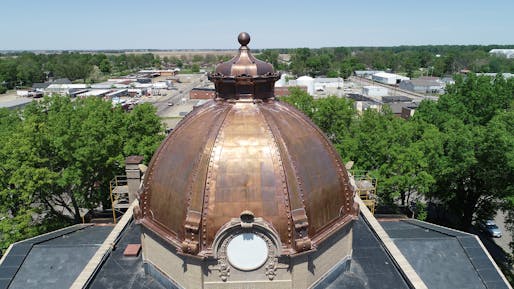
Mississippi County Courthouse Dome Replacement by Revival Architecture, Inc. Photo: Renaissance Historic Exteriors
Description: After meticulous measurement and documentation, every effort was made to match the original ornamental detailing of the original dome. Upon study of how the copper had performed after over 100 years of use, improvements were made to lock seams and heavier weight copper was utilized where needed. With the dome repaired, and other improvements made to the building, this courthouse can now serve future generations for at least another one hundred years.
The scope of the Osceola project was to remove and replace all deteriorated copper elements of the copper dome, including spheres, scrolls, cupola, and other various stamped elements. Approximately 14,000 pounds of 20-ounce copper was used on this project. As a registered National Historic Place, it was imperative that Renaissance work closely with the owner and architect to ensure all replacement elements adhered to historic requirements, architect drawings, and current codes.
Some current competitions on Bustler that may interest you…
Memorial for Witches
Register by Tue, Sep 20, 2022
Submit by Thu, Dec 15, 2022
Iceland Movie Pavilion
Register by Wed, Sep 14, 2022
Submit by Mon, Dec 12, 2022
A Rehabilitation Centre for Terrorism Victims in Iraq
Register by Fri, Sep 30, 2022
Submit by Sat, Oct 1, 2022
Architecture Graduation Projects Award 2022
Register by Wed, Aug 31, 2022
Submit by Thu, Sep 1, 2022
[ad_2]
Source link
